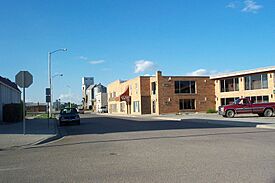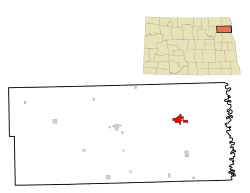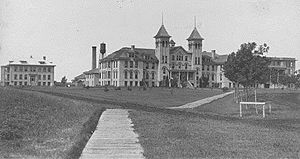Grafton, North Dakota facts for kids
Quick facts for kids
Grafton, North Dakota
|
|
|---|---|

Downtown Grafton
|
|

Location of Grafton, North Dakota
|
|
| Country | United States |
| State | North Dakota |
| County | Walsh |
| Founded | 1881 |
| Incorporated (village) | 1881 |
| Incorporated (town) | May 22, 1882 |
| Incorporated (city) | 1903 |
| Area | |
| • Total | 3.566 sq mi (9.236 km2) |
| • Land | 3.303 sq mi (8.554 km2) |
| • Water | 0.263 sq mi (0.681 km2) |
| Elevation | 827 ft (252 m) |
| Population
(2020)
|
|
| • Total | 4,170 |
| • Estimate
(2023)
|
4,059 |
| • Density | 1,229.0/sq mi (474.5/km2) |
| Time zone | UTC−6 (Central) |
| • Summer (DST) | UTC−5 (CDT) |
| ZIP Code |
58237
|
| Area code(s) | 701 |
| FIPS code | 38-31820 |
| GNIS feature ID | 1036063 |
| Highways | US 81, ND 17 |
| Sales tax | 7.75% |
Grafton is a city in North Dakota, United States. It is the main city and county seat of Walsh County. In 2020, about 4,170 people lived there.
Contents
History of Grafton
The land where Grafton now stands was first settled by Nils Monson in 1878. He was a 29-year-old who walked all the way from Winnipeg to start a farm. He gave his land to help create the town.
Later, in 1879, Thomas E. Cooper also settled in the area. He became the postmaster when a post office was built. This was part of new services for the Northern Pacific Railway and the Great Northern Railway.
Grafton was officially started in 1881. It became a village in the same year and then a city in 1903. Also in 1881, Walsh County was formed, and Grafton was chosen as its main city. The city was named after Grafton County in New Hampshire. Many of the first settlers came from there.
The Grafton State School, a special home for people with developmental disabilities, is a very old building. It is listed on the National Register of Historic Places because of its importance.
Geography of Grafton
Grafton covers an area of about 3.5 square miles (9.2 square kilometers). Most of this area is land, while a smaller part is water.
People of Grafton
| Historical population | |||
|---|---|---|---|
| Census | Pop. | %± | |
| 1890 | 1,594 | — | |
| 1900 | 2,378 | 49.2% | |
| 1910 | 2,229 | −6.3% | |
| 1920 | 2,512 | 12.7% | |
| 1930 | 3,136 | 24.8% | |
| 1940 | 4,070 | 29.8% | |
| 1950 | 4,901 | 20.4% | |
| 1960 | 5,885 | 20.1% | |
| 1970 | 5,946 | 1.0% | |
| 1980 | 5,293 | −11.0% | |
| 1990 | 4,840 | −8.6% | |
| 2000 | 4,516 | −6.7% | |
| 2010 | 4,284 | −5.1% | |
| 2020 | 4,170 | −2.7% | |
| 2023 (est.) | 4,059 | −5.3% | |
| U.S. Decennial Census 2020 Census |
|||
Population in 2020
In 2020, Grafton had 4,170 people living in 1,738 households. There were 986 families. The city had about 1,966 housing units.
Most people in Grafton were White (about 77.9%). There were also people who identified as African American, Native American, Asian, or from other backgrounds. About 21.9% of the population identified as Hispanic or Latino.
Population in 2010
In 2010, Grafton had 4,284 people. There were 1,776 households and 1,073 families. The average household had 2.27 people, and the average family had 2.92 people.
The average age of people in Grafton was 42.5 years old. About 23.5% of residents were under 18 years old. About 19.2% were 65 years or older. There were slightly more females (51.6%) than males (48.4%) in the city.
Education in Grafton
Grafton has its own public school system. It includes:
- Century Primary Elementary School (for students in Pre-Kindergarten to 2nd grade)
- Century Intermediate Elementary School (for students in 3rd to 6th grade)
- Grafton Junior High School (for students in 7th to 8th grade)
- Grafton High School (for students in 9th to 12th grade)
There is also the North Valley Career and Technology Center. This center helps high school students (grades 9-12) from Grafton and nearby areas learn special job skills.
Grafton's Library
Grafton is home to the Carnegie Regional Library. It opened in 1897 and was the very first public library in North Dakota! The library has over 49,000 books and other items. It serves more than 27,000 people, including its three smaller branches.
Media in Grafton
Grafton has local news sources to keep its residents informed.
- Walsh County Record is a local newspaper.
- Walsh County Daily News is another local news source.
There are also local radio stations:
- KXPO (1340 AM) plays country music.
- KAUJ (100.9 FM) plays oldies music.
Places to Visit in Grafton
Grafton has several interesting places:
- Walsh County Courthouse – This historic building has been on the National Register of Historic Places since 1985.
- Centennial Center – A community center.
- Elmwood historic home – An old, important house.
- Fair Oaks Golf Club – A nine-hole golf course where you can play golf.
- Grafton Winter Sports Arena – This was the first indoor hockey arena in North Dakota.
- Chandler Field – A field named after Albert "Happy" Chandler.
- Leistikow Park – A local park.
Famous People from Grafton
Many notable people have connections to Grafton:
- Karen Anderson – A state legislator.
- Albert "Happy" Chandler – He was the governor of Kentucky twice and a US senator. He also served as the commissioner of Major League Baseball.
- Pablo Garza – A mixed martial arts fighter who competed in the Ultimate Fighting Championship.
- William E. Gorder – A teacher, farmer, and state representative for North Dakota.
- Les Lear – An offensive tackle who played in both the Canadian Football League and the National Football League.
- Raymond W. Lessard – A bishop of Savannah from 1973 to 1995.
- Clint Ritchie – An actor known for playing Clint Buchanan on the TV show One Life to Live.
- Barry Tallackson – A forward who played for the St. Louis Blues hockey team.
See also
 In Spanish: Grafton (Dakota del Norte) para niños
In Spanish: Grafton (Dakota del Norte) para niños


